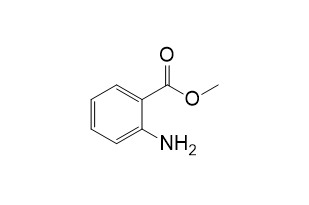Methyl anthranilate
Methyl anthranilate is a potent attractant for four species of flower thrips, Thrips hawaiiensis, T. coloratus, T. flavus, and Megalurothrips distalis, irrespective of sex. It also could be used as an additional marker in the determination of citrus honey origin.
Inquire / Order:
manager@chemfaces.com
Technical Inquiries:
service@chemfaces.com
Tel:
+86-27-84237783
Fax:
+86-27-84254680
Address:
1 Building, No. 83, CheCheng Rd., Wuhan Economic and Technological Development Zone, Wuhan, Hubei 430056, PRC
Providing storage is as stated on the product vial and the vial is kept tightly sealed, the product can be stored for up to
24 months(2-8C).
Wherever possible, you should prepare and use solutions on the same day. However, if you need to make up stock solutions in advance, we recommend that you store the solution as aliquots in tightly sealed vials at -20C. Generally, these will be useable for up to two weeks. Before use, and prior to opening the vial we recommend that you allow your product to equilibrate to room temperature for at least 1 hour.
Need more advice on solubility, usage and handling? Please email to: service@chemfaces.com
The packaging of the product may have turned upside down during transportation, resulting in the natural compounds adhering to the neck or cap of the vial. take the vial out of its packaging and gently shake to let the compounds fall to the bottom of the vial. for liquid products, centrifuge at 200-500 RPM to gather the liquid at the bottom of the vial. try to avoid loss or contamination during handling.
Foods.2020, 9(10):1348.
Food Chem Toxicol.2023, 176:113785.
Antioxidants2022, 11(2),234.
Polytechnic University of Catalonia2017, 105826
Molecules.2024, 29(22):5261.
Front Pharmacol.2021, 12:652860.
Phytomedicine.2024, 129:155645.
Cell Metab.2020, S1550-4131(20)30002-4
Plant Foods Hum Nutr.2021, 76(4):472-477.
Saudi Pharm J.2019, 27(1):145-153
Related and Featured Products
Applied Entomology & Zoology, 2001, 36(4):475-478.
Attractiveness of methyl anthranilate and its related compounds to the flower thrips, Thrips hawaiiensis (Morgan), T. coloratus Schmutz, T. flavus Schrank and Megalurothrips distalis (Karny) (Thysanoptera: Thripidae). [Reference:
WebLink]
METHODS AND RESULTS:
Methyl anthranilate, a common flower volatile component, was found to be a potent attractant for four species of flower thrips, Thrips hawaiiensis, T. coloratus, T. flavus, and Megalurothrips distalis, irrespective of sex. Methyl anthranilate attracted significantly larger numbers of these four species than p-anisaldehyde, an already-known attractant for several species of flower thrips.
CONCLUSIONS:
The attractiveness of the related compounds varied between the species: Within 13 related compounds; two positional isomers and 11 functional-group-substituted compounds; o-anisidine and o-aminoacetophenone for T. hawaiiensis, and methyl m-aminobenzoate, o-anisidine, methyl benzoate and methyl o-toluate for T. coloratus, were almost as attractive as Methyl anthranilate. Meanwhile, no compounds except for Methyl anthranilate were attractive to T. flavus and M. distalis.
Journal of the ence of Food & Agriculture, 2010, 65(3):371-372.
A comparative study of hesperetin and methyl anthranilate as markers of the floral origin of citrus honey.[Reference:
WebLink]
Methyl anthranilate (MA) and hesperetin have been compared as markers for the floral origin of citrus honey.
METHODS AND RESULTS:
In the present work the contents of MA and hesperetin have been determined by GC and HPLC respectively in 18 honey samples produced in Mediterranean Spain. There was no correlation between the contents of MA and hesperetin. The concentration of MA ranged between 1.44 and 3.60 mg kg-1 while hesperetin ranged between 0.28 and 0.84 mg kg-1.
CONCLUSIONS:
These results support the hypothesis that hesperetin could be used as an additional marker in the determination of citrus honey origin.



